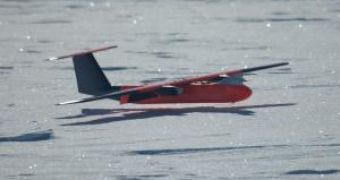It is the first time when an unpiloted Unmanned Autonomous Vehicle is used in the antarctic continent to gather data of the harsh environment. The UAV was developed by a British-German collaboration between the British Antarctic Survey and the Technical University of Braunschweig, and it has completed successfully all the scheduled flights.
According to Dr. Phil Anderson from the British Antarctic Survey, or BAS for short, the UAV is totally controlled through radio except for the take-offs and landings, it is completely autonomous and it follows a pre-determined patch schedule. During the tests conducted from October to December 2007, the UAV executed flights 40 minutes long thus traveling up to 45 kilometers, and made 100 measurements each second.
Twenty flights were completed in the test trials, in order to make measurements of heat exchange between the atmosphere and the layer of ice. The Antarctic Weddell Sea freezes during the winter season, to create a white reflecting layer of ice which bounces most of the light coming from the Sun, thus helping regulate the clime of the Earth. "UAVs allow scientists to reach the parts others cannot reach - the future of much atmospheric research will be robots," said Dr. Anderson.
One of the biggest challenges encountered by the BAS-TUBS collaboration was learning how to keep the batteries operational at extremely low temperatures and how to operate the UAV through radio signals during the take-offs and landings. "UAVs are physically harder to operate in the antarctic, but far easier in safely terms because there is virtually nothing sensitive to hit. Our next challenge will be to operate UAVs in the depths of the Antarctic winter," said Anderson.
The Antarctic UAV is electric-powered by Lithium Ion Polymer batteries in order to conduct atmospheric studies, weighs 6 kilograms and has a wing span of 2 meters, and is launched with the help of a catapult. After completing the mission, the UAV lands directly onto the snow on the ground.

 14 DAY TRIAL //
14 DAY TRIAL //